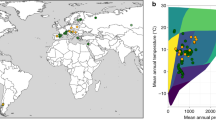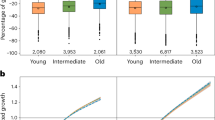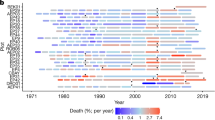Abstract
The frequency of severe droughts is increasing in many regions around the world as a result of climate change1–3. Droughts alter the structure and function of forests4,5. Site- and region-specific studies suggest that large trees, which play keystone roles in forests6 and can be disproportionately important to ecosystem carbon storage7 and hydrology8, exhibit greater sensitivity to drought than small trees4,5,9,10. Here, we synthesize data on tree growth and mortality collected during 40 drought events in forests worldwide to see whether this size-dependent sensitivity to drought holds more widely. We find that droughts consistently had a more detrimental impact on the growth and mortality rates of larger trees. Moreover, drought-related mortality increased with tree size in 65% of the droughts examined, especially when community-wide mortality was high or when bark beetles were present. The more pronounced drought sensitivity of larger trees could be underpinned by greater inherent vulnerability to hydraulic stress11–14, the higher radiation and evaporative demand experienced by exposed crowns4,15, and the tendency for bark beetles to preferentially attack larger trees16. We suggest that future droughts will have a more detrimental impact on the growth and mortality of larger trees, potentially exacerbating feedbacks to climate change.
This is a preview of subscription content, access via your institution
Access options
Subscribe to this journal
Receive 12 digital issues and online access to articles
$119.00 per year
only $9.92 per issue
Buy this article
- Purchase on Springer Link
- Instant access to full article PDF
Prices may be subject to local taxes which are calculated during checkout



Similar content being viewed by others
References
IPCC Climate Change 2013: The Physical Science Basis (eds Stocker, T. F. et al.) (Cambridge Univ. Press, 2013).
Trenberth, K. E. et al. Global warming and changes in drought. Nature Clim. Change 4, 17–22 (2014).
Settele, J. et al. in Climate Change 2014: Impacts, Adaptation and Vulnerability (eds Stocker, T. F. et al.) Ch. 4 (IPCC, Cambridge Univ. Press, 2014).
Nepstad, D. C., Tohver, I. M., Ray, D., Moutinho, P. & Cardinot, G. Mortality of large trees and lianas following experimental drought in an Amazon forest. Ecology 88, 2259–2269 (2007).
Phillips, O. L. et al. Drought-mortality relationships for tropical forests. New Phytol. 187, 631–646 (2010).
Lindenmayer, D. B., Laurance, W. F. & Franklin, J. F. Global decline in large old trees. Science 338, 1305–1306 (2012).
Lutz, J. A., Larson, A. J., Swanson, M. E. & Freund, J. A. Ecological importance of large-diameter trees in a temperate mixed-conifer forest. PLoS ONE 7, e36131 (2012).
Wullschleger, S. D., Hanson, P. & Todd, D. Transpiration from a multi-species deciduous forest as estimated by xylem sap flow techniques. For. Ecol. Manag. 143, 205–213 (2001).
Meinzer, F. C. et al. Partitioning of soil water among canopy trees in a seasonally dry tropical forest. Oecologia 121, 293 (1999).
Stahl, C. et al. Depth of soil water uptake by tropical rainforest trees during dry periods: does tree dimension matter? Oecologia 173, 1191–1201 (2013).
Ryan, M. G., Phillips, N. & Bond, B. J. The hydraulic limitation hypothesis revisited. Plant Cell Environ. 29, 367–381 (2006).
Zhang, Y.-J. et al. Size-dependent mortality in a Neotropical savanna tree: the role of height-related adjustments in hydraulic architecture and carbon allocation. Plant Cell Environ. 32, 1456–1466 (2009).
McDowell, N. G. & Allen, C. D. Darcy's law predicts widespread forest mortality under climate warming. Nat. Clim. Change 5, 669–672 (2015).
McDowell, N. G., Bond, B. J., Hill, L., Ryan, M. G. & Whitehead, D. in Size and age related changes in tree structure and function (eds Meinzer, F.C. & Niinemets, U. ) 255–286 (Springer Publishing, 2011).
Roberts, J., Cabral, O. M. R. & Aguiar, L. F. de. Stomatal and boundary-layer conductances in an Amazonian terra firme rain forest. J. Appl. Ecol. 27, 336–353 (1990).
Pfeifer, E. M., Hicke, J. A. & Meddens, A. J. H. Observations and modeling of aboveground tree carbon stocks and fluxes following a bark beetle outbreak in the western United States. Glob. Change Biol. 17, 339–350 (2011).
Chapin, F. S., Randerson, J. T., McGuire, A. D., Foley, J. A. & Field, C. B. Changing feedbacks in the climate–biosphere system. Front. Ecol. Environ. 6, 313–320 (2008).
Jiang, X. et al. Projected future changes in vegetation in western North America in the twenty-first century. J. Clim. 26, 3671–3687 (2013).
Allen, C. D. et al. A global overview of drought and heat-induced tree mortality reveals emerging climate change risks for forests. For. Ecol. Manag. 259, 660–684 (2010).
Breshears, D. D. et al. Regional vegetation die-off in response to global-change-type drought. Proc. Natl Acad. Sci. USA 102, 15144–15148 (2005).
Van Nieuwstadt, M. G. L. & Sheil, D. Drought, fire and tree survival in a Borneo rain forest, East Kalimantan, Indonesia. J. Ecol. 93, 191–201 (2005).
Condit, R., Hubbell, S. P. & Foster, R. B. Mortality rates of 205 neotropical tree and shrub species and the impact of a severe drought. Ecol. Monogr. 65, 419–439 (1995).
Mueller, R. C. et al. Differential tree mortality in response to severe drought: evidence for long-term vegetation shifts. J. Ecol. 93, 1085–1093 (2005).
Anderson-Teixeira, K. J. et al. Size-related scaling of tree form and function in a mixed-age forest. Funct. Ecol. http://dx.doi.org/10.1111/1365-2435.12470 (2015).
Poorter, H. et al. Biomass allocation to leaves, stems and roots: meta-analyses of interspecific variation and environmental control: Tansley review. New Phytol. 193, 30–50 (2012).
Condit, R. et al. Quantifying the deciduousness of tropical forest canopies under varying climates. J. Veg. Sci. 11, 649–658 (2000).
Laurance, W. F. & Williamson, G. B. Positive feedbacks among forest fragmentation, drought, and climate change in the Amazon. Conserv. Biol. 15, 1529–1535 (2001).
Doughty, C. E. et al. Drought impact on forest carbon dynamics and fluxes in Amazonia. Nature 519, 78–82 (2015).
da Costa, A. C. L. et al. Effect of 7 yr of experimental drought on vegetation dynamics and biomass storage of an eastern Amazonian rainforest. New Phytol. 187, 579–591 (2010).
Mattson, W. J. & Haack, R. A. the role of drought in outbreaks of plant-eating insects. BioScience 37, 110–118 (1987).
Acknowledgements
Thanks to all authors of the original studies included in this analysis; to J.A. Lutz, S.M. McMahon, A.D. Miller, A.J. Tepley, L. Poorter and A. Macalady for helpful feedback, and to J. Park, E. Bowman, M. Wang and J. Pearce for help with literature review and data compilation. This research was funded by a Smithsonian Competitive Grants Program for Science grant to KAT. NGM was supported by the Department of Energy, Office of Biological and Environmental Research, including through the Next Generation Ecosystem Experiment (NGEE) Tropics project and through Los Alamos National Lab's Laboratory Directed Research and Development. C.D.A. was supported by the U.S. Geological Survey's Ecosystems and Climate & Land Use Change mission areas, through the USGS Western Mountain Initiative project. Any use of trade, firm, or product names is for descriptive purposes only and does not imply endorsement by the U.S. Government.
Author information
Authors and Affiliations
Contributions
K.A.T., A.C.B. and N.G.M. conceived and designed the analysis, A.C.B., C.D.A. and K.A.T. compiled data; K.A.T. and A.C.B. analysed data; A.C.B., K.A.T., N.G.M. and C.D.A wrote the paper.
Corresponding author
Ethics declarations
Competing interests
The authors declare no competing financial interests.
Supplementary information
Rights and permissions
About this article
Cite this article
Bennett, A., McDowell, N., Allen, C. et al. Larger trees suffer most during drought in forests worldwide. Nature Plants 1, 15139 (2015). https://doi.org/10.1038/nplants.2015.139
Received:
Accepted:
Published:
DOI: https://doi.org/10.1038/nplants.2015.139
This article is cited by
-
Species-specific, size-dependent, and environmentally modulated growth resilience to drought in conifer forests on the Eastern Tibetan Plateau
European Journal of Forest Research (2024)
-
Novel light regimes in European forests
Nature Ecology & Evolution (2023)
-
Tree mortality during long-term droughts is lower in structurally complex forest stands
Nature Communications (2023)
-
Thermal Infrared Remote Sensing of Stress Responses in Forest Environments: a Review of Developments, Challenges, and Opportunities
Current Forestry Reports (2023)
-
Vessel tapering is conserved along a precipitation gradient in tropical trees of the genus Cedrela
Trees (2023)



